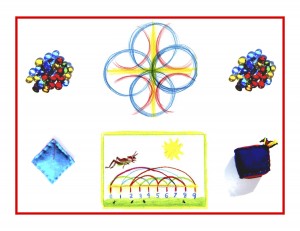Day 11
For one year, 365 days, this blog will address the Common Core Standards from the perspective of creating an alternate, ambient learning environment for math. Ambient is defined as “existing or present on all sides, an all-encompassing atmosphere.” And ambient music is defined as: “Quiet and relaxing with melodies that repeat many times.”
Why ambient? A math teaching style that’s whole and all encompassing, with themes that repeat many times through the years, is most likely to be effective and successful. Today’s blog will focus on Kindergarten Standard 5, in Operations and Algebraic Thinking. Note that the Common Core Standards will appear in blue, followed by an ambient translation.
5. Fluently add and subtract within 5.
First, a word about testing for Common Core Standards. It is my understanding that formal testing does not begin until Grade 3, but that teachers are encouraged/required to apply benchmarks and assessments regularly, (quarterly for each standard) starting in Kindergarten.
The assessment/testing expectation for Kindergarten is that a rigorous foundation upon which further math knowledge and skills can be added is being laid. But if teaching and learning is to reflect the qualities, beauty, and wholeness of math, then it must be three dimensional at all times: including the head, heart, and hands. And it needs to be deeply interwoven with life and direct experience.
The assessment branch of the Common Core is PARCC: Partnership for Assessment of Readiness for College and Careers. In the PARCC Model Content Frameworks for Mathematics / Version 3.0 – November 2012, “fluency” is described as:
“Wherever the word fluently appears in a content standard, the word means quickly and accurately. It means more or less the same as when someone is said to be fluent in a foreign language. To be fluent is to flow: Fluent isn’t halting, stumbling, or reversing oneself. A key aspect of fluency in this sense is that it is not something that happens all at once in a single grade but requires attention to student understanding along the way. It is important to ensure that sufficient practice and extra support are provided at each grade to allow all students to meet the standards that call explicitly for fluency.”
In that light, we could say that slow learning goes deepest, and that if the predisposition of the child up to age 7 is taken into account, abstract learning has no place in the Kindergarten. So, how to best insure that your Kindergartner(s) can fluently add and subtract within 5?
Using objects to effectively see the quantities is essential. Here’s how to proceed: place 5 objects (acorns, small stones, shells, etc.) on a flat surface and lay your hand over them, saying, “Five.” Have the child(ren) do the same. Move 2 objects to the side and say, “Take away 2,” laying your hand over the 2. Have the child(ren) do the same. Then place your hand over the 3 objects and say, “Is 3.” Have the child(ren) do the same.
After exploring all possible combinations in subtraction, move on to addition using the word “and” in place of “take away.” Again, the Kindergartner’s inclination toward imitation will assure that this task is repeatedly practiced, with little prompting from you.
Later, after fluency with objects is attained, you could have the child(ren) translate this into writing by using lines up to 5 to represent the numbers. Now would be a good time to introduce some of the 4 processes signs. Here’s a way to do that:
Hold your hands in front of you in fists with the index fingers pointing in the opposite directions. Say that the “is” sign points to both numbers to show that they are the same. You could start out attaching little arrows to the end of both lines for better understanding of the concept.
For the plus and minus signs you could say that the “take away” sign is empty “-” and the “and” sign is full “+” (just as a visual aid). Then have the child(ren) represent the equations like this: l l l l l – l l = l l l or l l + l l = l l l l.
Knowledge ensues in an environment dedicated to imaginative, creative knowing, where student and teacher alike surrender to the ensuing of that knowledge as a worthy goal. More Kindergarten tomorrow!












